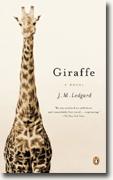Giraffe
J.M. Ledgard
book reviews:
· general fiction
· chick lit/romance
· sci-fi/fantasy
· graphic novels
· nonfiction
· audio books
· author interviews
· children's books @
curledupkids.com
· DVD reviews @
curledupdvd.com
newsletter
win books
buy online
links
home
for authors
& publishers
for reviewers

 |
Giraffe J.M. Ledgard Penguin Paperback 298 pages July 2007 |
|
Giraffes are tall and graceful. They are, as the author of Giraffe
Ledgard informs us that this novel is based on a true story, but that the details are either the loose truth or fabricated, where what actually occurred has disappeared in record and memory. This is fine, however, because the story serves mostly as a metaphor for the similarly diseased Communist state of Czechoslovakia. The writing is heavily symbolic, overly so, with the massacre of giraffes culminating in many references and comparisons to the death of Christ. Giraffes, while nice to look at and rather large, may not exactly sit well with people as Jesus-surrogates in a novel. The story is told from a first-person point of view, mostly restricted to Emil, the 'Giraffe man' instructed to observe and take care of the animals from Africa to Czechoslovakia and when they arrive at the zoo, and Amina, a young sleep-walking girl who is fascinated by the grace and beauty of her city's newest arrivals. Also, we are introduced to the man who will eventually be forced to kill the animals and a scientist who is experimenting on the giraffe's blood. Finally, we have the point of view of Sněhurka, a white-bellied giraffe - Sněhurka meaning 'snow white' in Czech. Each of the different perspectives seems very similar, which is somewhat bearable when humans are involved, but bizarre and wrong-seeming when a giraffe is included. Why must all of the characters have exactly the same personality - which is, to be clear, no personality at all? Characters wander through streets and comment on the dreaminess of it all, and then they sit down and discuss things in very great detail with one another, massive stretches of information, not conversation. Further to that, the characters are very 'I' focused, in that most sentences start with 'I', which limits the strength of narrative cohesion. There is a feeling that the novel will never escape its own small boundaries. An example: 'I go to stand before the sink and sponge under my arms and between my legs. The dress I pull on clings to my skin. I put a kettle on the stove and light a flame under it. I stand still, listening to the music. I look up once more...' I, I, I, I, I. The construction of sentences, paragraphs and chapters suffer from this unvarying opening. Ledgard barely allows himself to breathe amongst the strict rules associated with such repetitious 'I'. The last third of the novel is devoted almost exclusively to the massacre of the giraffes, an ending that is never made secret throughout the work. For all its dream-like vagueness, the story does have a sinister, lurking aspect in that we know a great deal of death is soon to come. And when it does, it is surprisingly effective. The killing is told from the point of view of all characters, excluding Sněhurka. Scenes of death and snippets of conversation are repeated, over and over again. The metaphor underlying this death is one of violence and destruction heralding the birth of something new, something better – and, as world history tells us, Communism was to die a few decades later. This metaphor is heavy-handed and distracting, but the power of repetition in the writing redeems the death of the giraffes. It is a confusing book which has a very weak first two-thirds and a comparatively much stronger final third. Where, then, does the novel stand? This is Ledgard's first novel, which allows him a great deal of slack. The text is easily digestible, which means the final section will quickly approach. But is it right to ask the reader to wade through two hundred pages of dreamy, ill-focused symbolism to arrive at admittedly quality writing and powerful imagery? This reviewer remains undecided. There is a lot that went wrong with Giraffe Originally published on Curled Up With A Good Book at www.curledup.com. © Damian Kelleher, 2007 |
|
|
|
 Click here to learn more about this month's sponsor! |
|
| fiction · sf/f · comic books · nonfiction · audio newsletter · free book contest · buy books online review index · links · · authors & publishers reviewers |
|
| site by ELBO Computing Resources, Inc. | |
 In 1975 Czechoslovakia, the Dvur Kralove Zoo was ordered to close its gate and prepare for a massacre of all animals infected with an African disease that could , if the disease spread, cause illness and death to millions of sheep and cows. The responsibility for the disease was placed in the hands - hooves - of thirty-two giraffes imported from Africa in 1972, which one character describes as the 'greatest migration of giraffes the world has ever seen.' Be that as it may, by 1975 the herd had increased to forty-nine, and all were to be killed, immediately.
In 1975 Czechoslovakia, the Dvur Kralove Zoo was ordered to close its gate and prepare for a massacre of all animals infected with an African disease that could , if the disease spread, cause illness and death to millions of sheep and cows. The responsibility for the disease was placed in the hands - hooves - of thirty-two giraffes imported from Africa in 1972, which one character describes as the 'greatest migration of giraffes the world has ever seen.' Be that as it may, by 1975 the herd had increased to forty-nine, and all were to be killed, immediately.